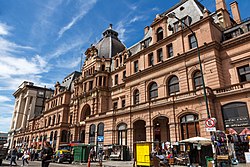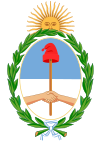Nuevos Ferrocarriles Argentinos
 | |
 Constitución railway station, head office | |
| Trenes Argentinos | |
| Type | State-owned |
| Industry | Railway |
| Predecessor | Ferrocarriles Argentinos |
| Founded | May 20, 2015 in Argentina[1] |
| Founder | Government of Argentina |
| Headquarters | Constitución railway station[2], , |
Area served | National |
Key people | Rodrigo Rufeil (President)[3] |
| Services | Rail transport, maintenance |
| Owner | Government of Argentina |
| Parent | Ministry of Transport |
| Divisions |
|
| Website | argentina.gob.ar/fase |
Ferrocarriles Argentinos Sociedad del Estado)[1] (doing business as Trenes Argentinos S.E.) is a state-owned railway company of Argentina created for the operation and maintenance of the Argentine railway network in the country, including passenger and freight services, and infrastructure.[4][5][6][7] The company shares its name with the previous national operator which was broken up during the privatisation process, and also uses a modified version of its original logo.
From its creation, state-owned companies managed by the company are Trenes Argentinos Operaciones (passenger services), Trenes Argentinos Cargas (freight), Trenes Argentinos Infraestructura (infrastructure),[8] and Trenes Argentinos Capital Humano (human resources)[2]
In March 2021, Minister of Transport announced that Ferrocarriles Argentinos S.E. would be put operative again, after an almost 5-year hiatus during the presidency of Mauricio Macri.[2][9]
History[]

The project to nationalise all the Argentine railway network had been announced by President Cristina Fernández de Kirchner during her speech at the Congress of Argentina's 133rd-year inaugural session on 1 March 2015.[10][11]

At the time the project was sent to the Congress to be discussed, only Belgrano Norte and Urquiza lines (operated by Ferrovías and Metrovías respectively) were under private concessions for passenger services, while Nuevo Central Argentino (NCA), Ferroexpreso Pampeano and Ferrosur companies operated freight trains.[8]
On 15 April 2015, the Congress of Argentina adopted the creation of "Ferrocarriles Argentinos Sociedad del Estado", with 53 votes in favour and 2 votes against.[6][12] Therefore, the Government of Argentina will take over the operation and maintenance of all the railway lines after they had granted to private companies during Carlos Menem's administration in the early 1990s.[7] The re-nationalisation law was officially promulgated on May 20, 2015.[1]
It was also announced that private companies still operating services at the time the law was promulgated, Nuevo Central Argentino, Ferroexpreso Pampeano, Ferrosur Roca, Metrovías and Ferrovías will continue their activities although Ferrocarriles Argentinos S.E. will be able to renegotiate or even cancel the contracts of concession.[7]
As part of a plan of rail transport modernisation announced by the Ministry of Transport led by Mario Meoni,[13] on March 8, 2021, "Ferrocarriles Argentinos S.E." was relaunched, setting its new offices at Constitución railway station. FASE had been inactive during the government of Mauricio Macri, when its divisions operated independently. The relaunch included a new logo, inspired on the homonymous company dissolves in 1993.[2][9]
Organizational structure[]

By 2015, the board of directors had six members: a representative of the Secretary of Transport, the presidents of ADIF, SOFSE and Belgrano CyL and other two representatives appointed by the Ministry of Transport according to proposals sent by several railway unions registered.[14]
The company also plans, operates and controls all the railway system in Argentina, both passenger and freight services.[8] The railway system is managed under a model of "open access" where several private operators are able to serve freight services along the lines.[14]
Divisions[]
Four divisions operate under the supervision of FASE, as it was announced in March 2021:[2]
- Trenes Argentinos Operaciones – passenger services
- Trenes Argentinos Cargas – freight services
- Trenes Argentinos Infraestructura (ADIFSE) – infrastructure
- Trenes Argentinos Capital Humano - Human resources
See also[]
- Ferrocarriles Argentinos – predecessor company, operated from 1949 to 1993
- Rail transport in Argentina
References[]
- ^ a b c Ley 27.132 - Ferrocarriles Argentinos, Boletín Oficial, 21 May 2015
- ^ a b c d e Relanzan Ferrocarriles Argentinos on En El Subte, 6 Mar 2021
- ^ Ferrocarriles Argentinos retoma la agenda, 7 Jul 2021
- ^ "Senado convirtió en ley estatización de trenes", Ambito Financiero, 16 Apr 2015
- ^ "Con sólo dos votos en contra, el Senado sancionó la ley de estatización de los trenes", Cronista.com, 16 Apr 2015
- ^ a b "El Senado convirtió en ley la estatización de los ferrocarriles", Infobae, 15 Apr 2015
- ^ a b c "El Senado convirtió en ley la estatización de los ferrocarriles", La Nación, 15 Apr 2015
- ^ a b c "El Estado recupera la administración de todas las vías del país y pondrá bajo análisis todas las concesiones", Telam, 18 Mar 2015
- ^ a b Ferrocarriles Argentinos nuevamente tracciona, Rieles, 10 Mar 2021
- ^ "Cristina anunció la estatización de los ferrocarriles", Télam, 1 Mar 2015
- ^ "Cristina anunció la estatización de los ferrocarriles", La Gazeta de Salta, 1 Mar 2015
- ^ "Trenes: el oficialismo logró la ley de estatización", Clarín, iEco, 16 Apr 2015
- ^ Cómo es el Plan de Modernización Ferroviaria que busca beneficiar a más de un millón de personas by David Cayón on Infobae, 14 Mar 2021
- ^ a b "Otra vuelta para los Ferrocarriles Argentinos", Página/12, 20 Mar 2015
External links[]
| Wikimedia Commons has media related to Ferrocarriles Argentinos Sociedad del Estado. |
- Railway companies of Argentina
- Railway companies established in 2015
- Argentine companies established in 2015
- Government-owned railway companies
